Also known as Catastrophe of Smyrna Role Catastrophe | Name Great of Date September 1922 | |
 | ||
Location Smyrna (today Izmir, Turkey) Outcome Exodus of the Greek and Armenian population of the city and destruction of their quarters | ||
The Great Catastrophic Fire Of Smyrna - Izmir
The Great Fire of Smyrna or the Catastrophe of Smyrna (Greek: Καταστροφή της Σμύρνης, "Smyrna Catastrophe"; Turkish: 1922 İzmir Yangını, "1922 Izmir Fire"; Armenian: Զմիւռնիոյ Մեծ Հրդեհ, Zmiwrrnioy Mets Hrdeh) destroyed much of the port city of Smyrna (modern İzmir, Turkey) in September 1922. Eyewitness reports state that the fire began on 13 September 1922 and lasted until it was largely extinguished on 22 September. It occurred four days after the Turkish forces regained control of the city on 9 September 1922, effectively ending the Greco-Turkish War in the field, more than three years after the Greek army had landed troops at Smyrna on 15 May 1919. Estimated Greek and Armenian deaths resulting from the fire range from 10,000 to 100,000.
Contents
- The Great Catastrophic Fire Of Smyrna Izmir
- Glen beck spotlights the great fire of smyrna
- Background
- Entry of the Turkish Army
- Burning
- Aftermath
- Historiography
- Casualties and refugees
- In art music and literature
- References
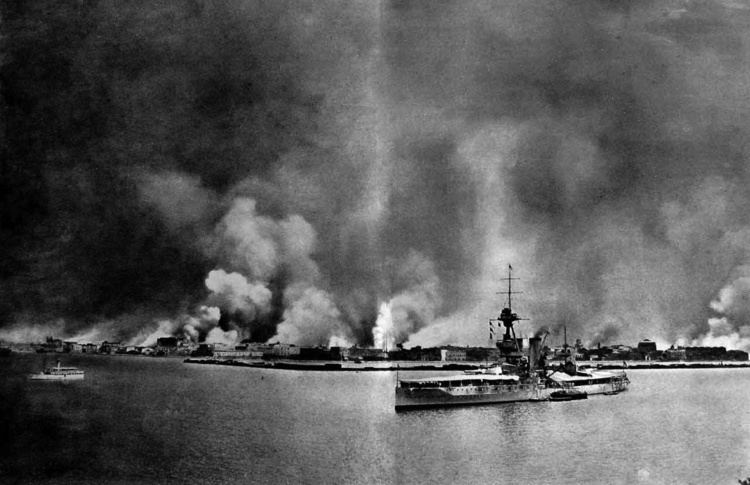
Approximately 50,000 to 400,000 Greek and Armenian refugees crammed the waterfront to escape from the fire. They were forced to remain there under harsh conditions for nearly two weeks. Turkish troops and irregulars had started committing massacres and atrocities against the Greek and Armenian population in the city before the outbreak of the fire. Many women were raped.
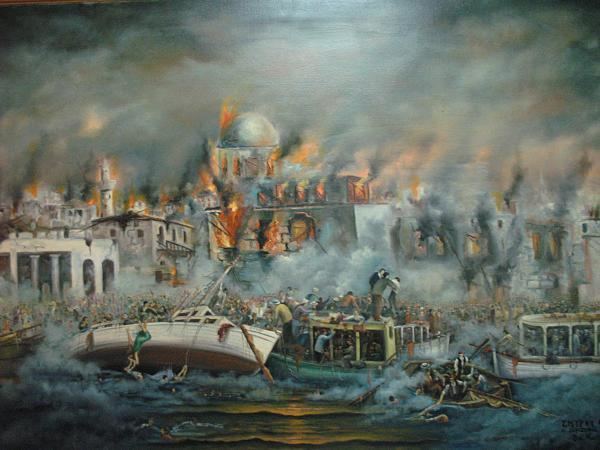
The subsequent fire completely destroyed the Greek and Armenian quarters of the city; the Muslim and Jewish quarters escaped damage. There are different accounts and eyewitness reports about who was responsible for the fire; a number of sources and scholars attribute it to Turkish soldiers setting fire to Greek and Armenian homes and businesses. Traditional Turkish sources hold that the Greeks and Armenians started the fire. Testimonies from western eyewitnesses were printed in many western newspapers.
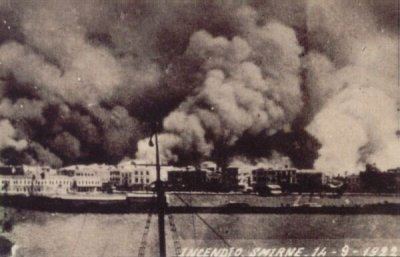
Glen beck spotlights the great fire of smyrna
Background
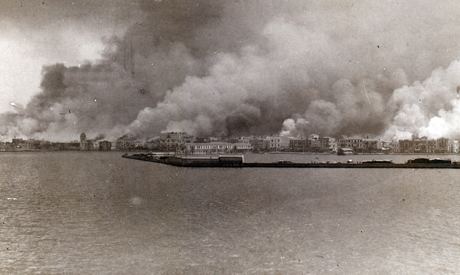
The ratio of Christian population to Muslim population remains a matter of dispute, but the city was a multicultural and cosmopolitan center until September 1922. Different sources claim either Greeks or Turks as constituting the majority in the city. According to Katherine Elizabeth Flemming, in 1919–1922 the Greeks in Smyrna numbered 150,000, forming just under half of the population, outnumbering the Turks by a ratio of two to one. Alongside Turks and Greeks, there were sizeable Armenian, Jewish, and Levantine communities in the city. According to Trudy Ring, before World War I the Greeks alone numbered 130,000 out of a population of 250,000, excluding Armenians and other Christians.
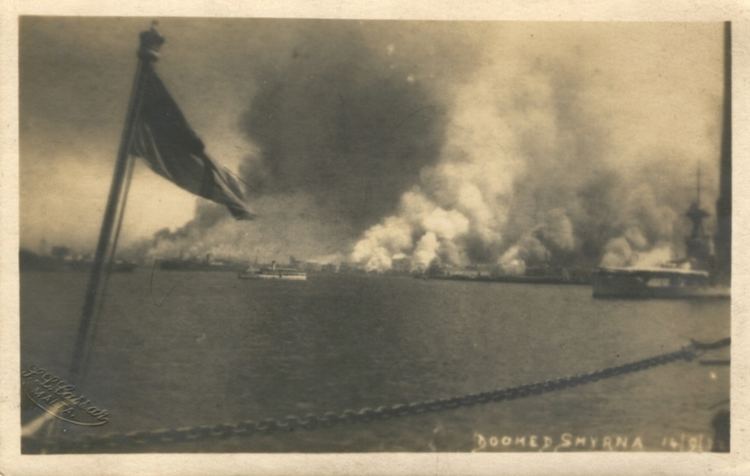
According to the Ottoman census of 1905, there were 100,356 Muslims, 73,636 Orthodox Christians, 11,127 Armenian Christians, and 25,854 others; the updated figures for 1914 gave 111,486 Muslims compared to 87,497 Orthodox Christians.

According to the U.S. Ambassador to the Ottoman Empire at the time, Henry Morgenthau, more than half of Smyrna's population was Greek. The American Consul General in Smyrna at the time, George Horton, wrote that before the fire there were 400,000 people living in the city of Smyrna, of whom 165,000 were Turks, 150,000 were Greeks, 25,000 were Jews, 25,000 were Armenians, and 20,000 were foreigners—10,000 Italians, 3,000 French, 2,000 British, and 300 Americans. Most of the Greeks and Armenians were Christians.
Moreover, according to various scholars, prior to the war, the city was a center of more Greeks than lived in Athens, the capital of Greece. The Ottomans of that era referred to the city as Infidel Smyrna (Gavur Izmir) due to the numerous Greeks and the large non-Muslim population.
Entry of the Turkish Army
As the last Greek troops evacuated Smyrna on the evening of Friday 8 September, the first elements of Mustafa Kemal's forces, a Turkish cavalry squadron, made its way into the city from the northern tip of the quay the following morning, establishing their headquarters at the main government building called Konak. Military command was first assumed by Mürsel Pasha and then Nureddin Pasha, General of the Turkish First Army. At the outset, the Turkish occupation of the city was orderly. Though the Armenian and Greek inhabitants viewed their entry with trepidation, they reasoned that the presence of the Allied fleet would discourage any violence against the Christian community. On the morning of September 9, no fewer than twenty-one Allied warships lay at anchor in Smyrna's harbor, including the British flagship battleship HMS Iron Duke and her sister King George V, along with their escort of cruisers and destroyers under the command of Admiral Osmond Brock, the American destroyers USS Litchfield, Simpson, and Lawrence (later joined by the Edsall), three French cruisers and two destroyers under the command of Admiral Dumesnil, and an Italian cruiser and destroyer. As a precaution, sailors and marines from the Allied fleet were landed ashore to guard their respective diplomatic compounds and institutions with strict orders of maintaining neutrality in the event that violence would break out between the Turks and the Christians.
As it happened, on 9 September, order and discipline began to break down among the Turkish troops, who began systematically to target the Armenian population, pillaging their shops, looting their homes, separating the men from the women and carrying away and sexually assaulting the latter. The Greek Orthodox Metropolitan bishop, Chrysostomos, was tortured and hacked to death by a Turkish mob in full view of French soldiers, who were prevented from intervening by their commanding officer, and much to Admiral Dumesnil's approval. Refuge was sought wherever possible, including Paradise, where the American quarter was located, and the European quarters. Some were able to take shelter at the American Collegiate Institute and other institutions, despite strenuous efforts to turn away those seeking help by the Americans and Europeans, who were anxious not to antagonize or harm their relations with the leaders of the Turkish National movement.
Victims of the massacres committed by the Turkish army and irregulars were also foreign citizens. On 9 September, Dutch merchant Otto de Jongh and his wife were murdered by the Turkish cavalry, while in another incident a retired British doctor was beaten to death in his home, while trying to prevent the rape of a servant girl.
Burning
The first fire broke out in the late afternoon of 13 September, four days after the Turkish Army had entered the city. The blaze began in the Armenian quarter of the city (Now borough of Basmane), and spread quickly due to the windy weather and the fact that no effort was made to put it out. According to author Giles Milton:
One of the first people to notice the outbreak of fire was Miss Minnie Mills, the director of the American Collegiate Institute for Girls. She had just finished her lunch when she noticed that one of the neighboring buildings was burning. She stood up to have a closer look and was shocked by what she witnessed. "I saw with my own eyes a Turkish officer enter the house with small tins of petroleum or benzine and in a few minutes the house was in flames." She was not the only one at the institute to see the outbreak of fire. "Our teachers and girls saw Turks in regular soldiers' uniforms and in several cases in officers' uniforms, using long sticks with rags at the end which were dipped in a can of liquid and carried into houses which were soon burning."
Others, such as Claflin Davis of the American Red Cross and Monsieur Joubert, director of the Credit Foncier Bank of Smyrna, also witnessed the Turks putting buildings to the torch. When the latter asked the soldiers what they were doing, "They replied impassively that they were under orders to blow up and burn all the houses of the area." The city's fire brigade did its best to combat the fires but by Wednesday September 13 so many were being set that it was unable to keep up. Two firemen from the brigade, a Sgt. Tchorbadjis and Emmanuel Katsaros, would later testify in court witnessing Turkish soldiers setting fire to the buildings. When Katsaros complained, one of them commented, "You have your orders...and we have ours. This is Armenian property. Our orders are to set fire to it." The spreading fire caused a stampede of people to flee towards the quay, which stretched from the western end of the city to its northern tip, known as the Point. Captain Arthur Japy Hepburn, chief of Staff of the American naval squadron, described the panic on the quay:
Returning to the street I found the stampede from the fire just beginning. All of the refugees that had been scattered through the streets or stowed in churches and other institutions were moving toward the waterfront. Steadily augmenting this flow were those abandoning their homes in the path of the fire...It was now dark. The quay was already filled with tens of thousands of terrified refugees moving aimlessly between the customs house and the point, and still the steady stream of new arrivals continued, until the entire waterfront seemed one solid mass of humanity and baggage of every description.
The heat from the fire was so intense that Hepburn was worried that the refugees would die as a result of it. The refugees' situation on the pier on the morning of September 14 was described by the British Lieutenant A. S. Merrill, who believed that the Turks had set the fire to keep the Greeks in a state of terror so as to facilitate their departure:
All morning the glow and then the flames of burning Smyrna could be seen. We arrived about an hour before dawn and the scene was indescribable. The entire city was ablaze and the harbor was light as day. Thousands of homeless refugees were surging back and forth on the blistering quay – panic stricken to the point of insanity. The heartrending shrieks of women and children were painful to hear. In a frenzy they would throw themselves into the water and some would reach the ship. To attempt to land a boat would have been disastrous. Several boats tried and were immediately stopped by the mad rush of a howling mob...The crowds along the quay beyond the fire were so thick and tried so desperately to close abreast the men-of-war anchorage that the masses in the stifling center could not escape except by sea. Fortunately there was a sea breeze and the quay wall never got hot enough to roast these unfortunate people alive, but the heat must have been terrific to have been felt in the ship 200 yards away. To add to the confusion, the packs belonging to these refugees – consisting mostly of carpets and clothing – caught fire, creating a chain of bonfires the length of the street.
Turkish troops cordoned off the Quay to box the Armenians and Greeks within the fire zone and prevent them from fleeing. Eyewitness reports describe panic-stricken refugees diving into the water to escape the flames and that their terrified screaming could be heard miles away. By September 15 the fire had somewhat died down, but sporadic violence by the Turks against the Greek and Armenian refugees kept the pressure on the Western and Greek navies to remove the refugees as quickly as possible. The fire was completely extinguished by September 22, and on September 24 the first Greek ships – part of a flotilla organized and commandeered by the American humanitarian Asa Jennings – entered the harbor to take passengers away, following Captain Hepburn's initiative and his having obtained permission and cooperation from the Turkish authorities and the British admiral in charge of the destroyers in the harbor.
Aftermath
The evacuation was difficult despite the efforts of British and American sailors to maintain order, as tens of thousands of refugees pushed and shoved towards the shore. Attempts to organize relief were made by the American officials from the YMCA and YWCA, who were reportedly robbed and later shot at by Turkish soldiers. On the quay, Turkish soldiers and irregulars periodically robbed Greek refugees, beating some and arresting others who resisted. Though there were several reports of well-behaved Turkish troops helping old women and trying to maintain order among the refugees, these are heavily outnumbered by those describing gratuitous cruelty, incessant robbery and violence.
American and British attempts to protect the Greeks from the Turks did little good, with the fire having taken a terrible toll. Some frustrated and terrified Greeks took their own lives, plunging into the water with packs at their back, children were stampeded, and many of the elderly fainted and died. The city's Armenians also suffered grievously, and according to Captain Hepburn, "every able-bodied Armenian man was hunted down and killed wherever found, with even boys aged 12 to 15 taking part in the hunt".
The fire completely destroyed the Greek, Armenian, and Levantine quarters of the city, with only the Turkish and Jewish quarters surviving. The thriving port of Smyrna, one of the most commercially active in the region, was burned to the ground. Some 150,000–200,000 Greek refugees were evacuated, while approximately 30,000 able-bodied Greek and Armenian men were deported to the interior, many of them dying under the harsh conditions or executed along the way. The 3,000 year Greek presence on Anatolia's Aegean shore was brought to an abrupt end, along with the Megali Idea. The Greek writer Dimitris Pentzopoulos wrote, "It is no exaggeration to call the year '1922' the most calamitous in modern Hellenic history."
Historiography
A number of studies have been published on the Smyrna fire. The most thorough is Professor of literature Marjorie Housepian Dobkin's Smyrna 1922, which concludes that the Turkish Army systematically burned the city and killed Christian Greek and Armenian inhabitants. Her work is based on extensive eyewitness testimony from survivors, Allied troops sent to Smyrna during the evacuation, foreign diplomats, relief workers, and Turkish eyewitnesses. A study by historian Niall Ferguson comes to the same conclusion. Historian Richard Clogg categorically states that the fire was started by the Turks following their capture of the city. In his book Paradise Lost: Smyrna 1922, Giles Milton addresses the issue of the Smyrna Fire through original material (interviews, unpublished letters, and diaries) from the Levantine families of Smyrna, who were mainly of British origin. All the documents collected by the author during this research are deposited in Exeter University Library. The conclusion of the author is that it was Turkish soldiers and officers who set the fire, most probably acting under direct orders. British scholar Michael Llewellyn-Smith, writing on the Greek administration in Asia Minor, also concludes that the fire was "probably lit" by the Turks as indicated by what he calls "what evidence there is".
American historian Norman Naimark has evaluated the evidence regarding the responsibility of the fire. He agrees with the view of American Lieutenant Merrill that it was in Turkish interests to terrorize Greeks into leaving Smyrna with the fire, and points out to the "odd" fact that the Turkish quarter was spared from the fire as a factor suggesting Turkish responsibility. However, he points out that there is no "solid and substantial evidence" of this and that it can be argued that burning the city was against Turkish interests and was unnecessary. He also suggests that the responsibility may lie with Greeks and Armenians as they "had own their good reasons", pointing out to the "Greek history of retreating" and "Armenian attack in the first day of the occupation".
Horton and Housepian are criticized by Heath Lowry and Justin McCarthy, who argue that Horton was highly prejudiced and Housepian makes an extremely selective use of sources. Lowry and McCarthy are members of the Institute of Turkish Studies and have in turn been strongly criticized by other scholars for their denial of the Armenian Genocide and McCarthy has been described by Michael Mann as being on "the Turkish side of the debate." Horton, however, has been criticised as anti-Turkish by a number of other scholars. Professor Biray Kolluoğlu Kırlı has accused Horton of having a "crudely explicit" anti-Turkish bias, while in his review of Horton's work, Professor Emeritus Peter M. Buzanski has attributed Horton's anti-Turkish stance to his well-known "fanatic" philhellenism and his wife being Greek, and written "During the Turkish capture of Smyrna, at the end of the Greco-Turkish War, Horton suffered a breakdown, resigned from the diplomatic service, and spent the balance of his life writing anti-Turkish, pro-Greek books." Brian Coleman, reviewing Horton's work, has characterised it as "a demonization of Muslims, in general, and of Turks, in particular" and stated that Horton wrote not as historian, but as publicist.
Turkish author and journalist Falih Rifki Atay, who was in Smyrna at the time, and the Turkish professor Biray Kolluoğlu Kırlı agreed that the Turkish Army was responsible for the destruction of Smyrna in 1922. More recently, a number of non-contemporary scholars, historians, and politicians have added to the history of the events by revisiting contemporary communications and histories. Leyla Neyzi, in her work on the oral history regarding the fire, makes a distinction between Turkish nationalist discourse and local narratives. In the local narratives, she points out to the Turkish forces being held responsible for at least not attempting to extinguish the fire effectively, or, at times, being held responsible for the fire itself.
Other accounts contradict some of the facts presented in the above works. These include a telegram sent by Mustafa Kemal, articles in contemporary newspapers, and a short non-contemporary essay by Turkish historian Reşat Kasaba of the University of Washington, who briefly describes events without making clear accusations.
The accounts of Jewish teachers in Smyrna, letters of Johannes Kolmodin (a Swedish Orientalist who was in Smyrna at the time), and Paul Grescovich say that Greeks or Armenians were responsible for the fire. R.A. Weight stated that "his clients showed that the fire, in its origin, was a small accidental fire, though it eventually destroyed a large section of the town".
Casualties and refugees
The number of casualties from the fire is not precisely known, with estimates of up to 100,000 Greeks and Armenians killed. American historian Norman Naimark gives a figure of 10,000–15,000 dead, while historian Richard Clogg gives a figure of 30,000. Larger estimates include that of John Freely at 50,000 and Rudolf Rummel at 100,000.
Although there were numerous ships from various Allied powers in the harbor of Smyrna, the vast majority of them cited "neutrality" and did not pick up Greeks and Armenians who were forced to flee from the fire and the Turkish troops retaking the city after the Greek Army defeat. Military bands played loud music to drown out the screams of those who were drowning in the harbor and who were forcefully prevented from boarding Allied ships. A Japanese freighter dumped all of its cargo and took on as many refugees as possible, taking them to the Greek port of Piraeus.
Many refugees were rescued via an impromptu relief flotilla organized by American missionary Asa Jennings. Other scholars give a different account of the events; they argue that the Turks first forbade foreign ships in the harbor to pick up the survivors, but, under pressure especially from Britain, France, and the United States, they allowed the rescue of all the Christians except males 17 to 45 years old. They intended to deport the latter into the interior, which "was regarded as a short life sentence to slavery under brutal masters, ended by mysterious death".
The number of refugees changes according to the source. Some contemporary newspapers claim that there were 400,000 Greek and Armenian refugees from Smyrna and the surrounding area who received Red Cross aid immediately after the destruction of the city. Stewart Matthew states that there were 250,000 refugees who were all non-Turks. Naimark gives a figure of 150,000–200,000 Greek refugees evacuated, with some 30,000 Greek and Armenian men deported to the interior of Anatolia, where most of them died under brutal conditions. Edward Hale Bierstadt and Helen Davidson Creighton say that there were at least 50,000 Greek and Armenian refugees. Some contemporary accounts also suggest the same number.
Aristotle Onassis, who was born in Smyrna and who later became the richest man in the world, was one of the Greek survivors. The various biographies of his life document aspects of his experiences during the Smyrna catastrophe. His life experiences were featured in the TV movie called Onassis, The Richest Man in the World.
During the Smyrna catastrophe, the Onassis family lost substantial property holdings, which were either taken or given to Turks as bribes to secure their safety and freedom. They became refugees, fleeing to Greece after the fire. However, Aristotle Onassis stayed behind to save his father, who had been placed in a Turkish concentration camp. He was successful in saving his father's life. During this period three of his uncles died. He also lost an aunt, her husband Chrysostomos Konialidis, and their daughter, who were burned to death when Turkish soldiers set fire to a church in Thyatira, where 500 Christians had found shelter to avoid Turkish soldiers and the great fire of Smyrna.
Aftermath
The entire city suffered substantial damage to its infrastructure. The core of the city literally had to be rebuilt from the ashes. Today, 40 hectares of the former fire area is a vast park (Kültürpark) serving as Turkey's largest open air exhibition center, including the İzmir International Fair, among others.
According to the first census in Turkey after the war, the total population of the city in 1927 was 184,254, of whom 162,144 (88%) were Muslims, the remainder numbering 22,110.
In art, music, and literature
The strange thing was, he said, how they screamed every night at midnight ... We were in the harbour and they were on the pier and at midnight they started screaming. We used to turn the searchlight on them to quiet them. That always did the trick.
